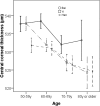Ethnic Variations in Central Corneal Thickness in a Rural Population in China: The Yunnan Minority Eye Studies
- PMID: 26274328
- PMCID: PMC4537213
- DOI: 10.1371/journal.pone.0135913
Ethnic Variations in Central Corneal Thickness in a Rural Population in China: The Yunnan Minority Eye Studies
Abstract
Purpose: To describe the ethnic differences in central corneal thickness (CCT) in population-based samples of ethnic Bai, Yi and Han people living in rural China.
Methods: 6504 adults (2119 ethnic Bai, 2202 ethnic Yi and 2183 ethnic Han) aged 50 years or older participated in the study. Each subject underwent standardized ocular examinations and interviewer-administered questionnaires for risk factor assessment. CCT was measured for both eyes using an ultrasound pachymeter. Regression and principal component analysis were performed to examine the relationship of ethnicity and other factors with CCT.
Results: The mean CCT readings were 536.4 ± 34.2 μm in ethnic Bai, 532.1 ± 32.1 μm in ethnic Yi and 529.6 ± 32.7 μm in ethnic Han adults (P<0.001), respectively. There was a decreasing trend of mean CCT with increasing age across all ethnic groups. In multivariate linear regression models, increasing CCT was associated with younger age (P<0.001), male gender (P<0.001), Bai (P<0.001) or Yi (P<0.001) ethnicity, greater body mass index (P<0.001), higher systolic blood pressure (P<0.001), greater corneal curvature (P<0.001), deeper anterior chamber (P < 0.001), and thicker lens (P<0.001). Ethnicity contributed significantly to presence of thin cornea (60%; P< 0.001) compared with other factors. CCT had similar impact on intraocular pressure readings across all ethnic groups.
Conclusions: This study of more than 6500 multiethnic participants demonstrates significant ethnic variations in CCT, with Han ethnicity having the thinnest cornea compared with ethnic minorities. These data are essential to guide future multiethnic clinical trials on CCT-related ocular conditions such as glaucoma.
Conflict of interest statement
Figures
Similar articles
-
Ethnic differences of intraocular pressure and central corneal thickness: the Singapore Epidemiology of Eye Diseases study.Ophthalmology. 2014 Oct;121(10):2013-22. doi: 10.1016/j.ophtha.2014.04.041. Epub 2014 Jun 18. Ophthalmology. 2014. PMID: 24950592
-
Association of Diabetes With Central Corneal Thickness Among a Multiethnic Asian Population.JAMA Netw Open. 2019 Jan 4;2(1):e186647. doi: 10.1001/jamanetworkopen.2018.6647. JAMA Netw Open. 2019. PMID: 30646192 Free PMC article.
-
Ethnic Variations in Pterygium in a Rural Population in Southwestern China: The Yunnan Minority Eye Studies.Ophthalmic Epidemiol. 2016;23(2):116-21. doi: 10.3109/09286586.2015.1099685. Epub 2016 Mar 7. Ophthalmic Epidemiol. 2016. PMID: 26950531
-
Central corneal thickness of Caucasians, Chinese, Hispanics, Filipinos, African Americans, and Japanese in a glaucoma clinic.Ophthalmology. 2004 Dec;111(12):2211-9. doi: 10.1016/j.ophtha.2004.06.013. Ophthalmology. 2004. PMID: 15582076
-
Central corneal thickness and its association with ocular and general parameters in Indians: the Central India Eye and Medical Study.Ophthalmology. 2010 Apr;117(4):705-10. doi: 10.1016/j.ophtha.2009.09.003. Epub 2010 Jan 4. Ophthalmology. 2010. PMID: 20045561
Cited by
-
Asian Race and Primary Open-Angle Glaucoma: Where Do We Stand?J Clin Med. 2022 Apr 28;11(9):2486. doi: 10.3390/jcm11092486. J Clin Med. 2022. PMID: 35566612 Free PMC article. Review.
-
Central Corneal Thickness in Spectral-Domain OCT and Associations with Ocular and Systemic Parameters.J Ophthalmol. 2016;2016:2596956. doi: 10.1155/2016/2596956. Epub 2016 Jun 2. J Ophthalmol. 2016. PMID: 27340561 Free PMC article.
-
Profile of central corneal thickness and corneal endothelial cell morpho-density of in healthy Congolese eyes.BMC Ophthalmol. 2021 Apr 22;21(1):185. doi: 10.1186/s12886-021-01947-x. BMC Ophthalmol. 2021. PMID: 33888064 Free PMC article.
-
Reference Values of the Central Corneal Thickness with Different Refractive Errors for the Adult Egyptian Population.Clin Ophthalmol. 2020 Oct 22;14:3465-3474. doi: 10.2147/OPTH.S277137. eCollection 2020. Clin Ophthalmol. 2020. PMID: 33122882 Free PMC article.
-
Central corneal thickness in a Jordanian population and its association with different types of Glaucoma: cross-sectional study.BMC Ophthalmol. 2018 Oct 29;18(1):279. doi: 10.1186/s12886-018-0944-6. BMC Ophthalmol. 2018. PMID: 30373555 Free PMC article.
References
-
- Brandt JD, Beiser JA, Kass MA, Gordon MO. Central corneal thickness in the Ocular Hypertension Treatment Study (OHTS). Ophthalmology. 2001;108(10):1779–88. . - PubMed
Publication types
MeSH terms
LinkOut - more resources
Full Text Sources
Other Literature Sources



